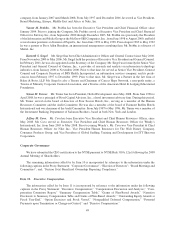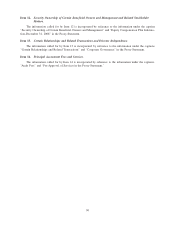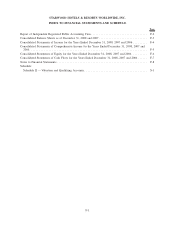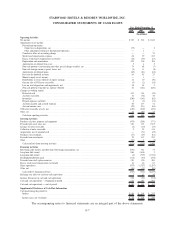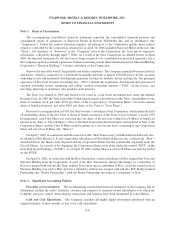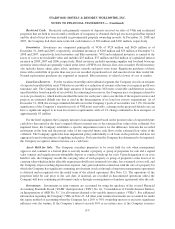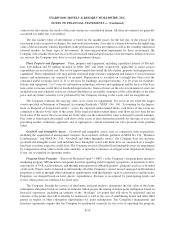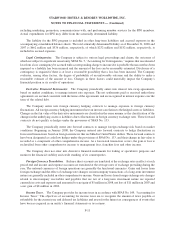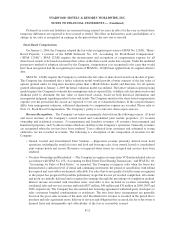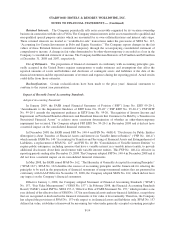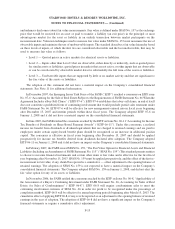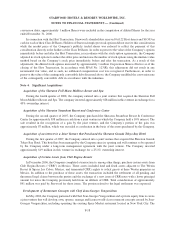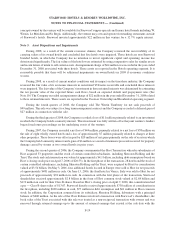Starwood 2008 Annual Report Download - page 125
Download and view the complete annual report
Please find page 125 of the 2008 Starwood annual report below. You can navigate through the pages in the report by either clicking on the pages listed below, or by using the keyword search tool below to find specific information within the annual report.Restricted Cash. Restricted cash primarily consists of deposits received on sales of VOIs and residential
properties that are held in escrow until a certificate of occupancy is obtained, the legal rescission period has expired
and the deed of trust has been recorded in governmental property ownership records. At December 31, 2008 and
2007, the Company had short-term restricted cash balances of $96 million and $196 million, respectively.
Inventories. Inventories are comprised principally of VOIs of $729 million and $620 million as of
December 31, 2008 and 2007, respectively, residential inventory of $203 million and $33 million at December 31,
2008 and 2007, respectively, hotel inventory and Bliss inventory. VOI and residential inventory is carried at the
lower of cost or net realizable value and includes $25 million, $37 million and $22 million of capitalized interest
incurred in 2008, 2007 and 2006, respectively. Hotel inventory includes operating supplies and food and beverage
inventory items which are generally valued at the lower of FIFO cost (first-in, first-out) or market. Hotel inventory
also includes linens, china, glass, silver, uniforms, utensils and guest room items. Significant purchases of these
items with a useful life of greater than one year are recorded at purchased cost and amortized over their useful life.
Normal replacement purchases are expensed as incurred. Bliss inventory is valued at lower of cost or market.
Loan Loss Reserves. For the vacation ownership and residential segment, the Company records an estimate
of expected uncollectibility on its VOI notes receivable as a reduction of revenue at the time it recognizes profit on a
timeshare sale. The Company holds large amounts of homogeneous VOI notes receivable and therefore assesses
uncollectibility based on pools of receivables. In estimating loss reserves, the Company uses a technique referred to
as static pool analysis, which tracks uncollectible notes for each year’s sales over the life of the respective notes and
projects an estimated default rate that is used in the determination of its loan loss reserve requirements. As of
December 31, 2008, the average estimated default rate for the Company’s pools of receivables was 7.9%. Given the
significance of the Company’s respective pools of VOI notes receivable, a change in the projected default rate can
have a significant impact to its loan loss reserve requirements, with a 0.1% change estimated to have an impact of
approximately $3 million.
For the hotel segment, the Company measures loan impairment based on the present value of expected future
cash flows discounted at the loan’s original effective interest rate or the estimated fair value of the collateral. For
impaired loans, the Company establishes a specific impairment reserve for the difference between the recorded
investment in the loan and the present value of the expected future cash flows or the estimated fair value of the
collateral. The Company applies the loan impairment policy individually to all loans in the portfolio and does not
aggregate loans for the purpose of applying such policy. For loans that the Company has determined to be impaired,
the Company recognizes interest income on a cash basis.
Assets Held for Sale. The Company considers properties to be assets held for sale when management
approves and commits to a formal plan to actively market a property or group of properties for sale and a signed
sales contract and significant non-refundable deposit or contract break-up fee exist. Upon designation as an asset
held for sale, the Company records the carrying value of each property or group of properties at the lower of its
carrying value which includes allocable segment goodwill or its estimated fair value, less estimated costs to sell, and
the Company stops recording depreciation expense. Any gain realized in connection with the sale of a property for
which the Company has significant continuing involvement (such as through a long-term management agreement)
is deferred and recognized over the initial term of the related agreement (See Note 12). The operations of the
properties held for sale prior to the sale date, if material, are recorded in discontinued operations unless the
Company will have continuing involvement (such as through a management or franchise agreement) after the sale.
Investments. Investments in joint ventures are accounted for using the guidance of the revised Financial
Accounting Standards Board (“FASB”) Interpretation (“FIN”) No. 46, “Consolidation of Variable Interest Entities,
an Interpretation of ARB No. 51,” for all ventures deemed to be variable interest entities (“VIEs”). See additional
information regarding the Company’s VIEs in Note 23. All other joint venture investments are accounted for under
the equity method of accounting when the Company has a 20% to 50% ownership interest or exercises significant
influence over the venture. If the Company’s interest exceeds 50% or in certain cases, if the Company exercises
F-9
STARWOOD HOTELS & RESORTS WORLDWIDE, INC.
NOTES TO FINANCIAL STATEMENTS — (Continued)


